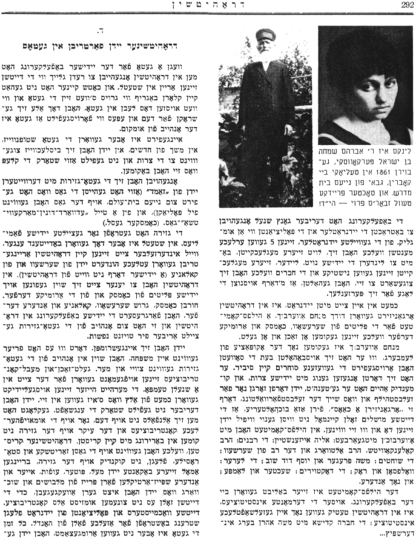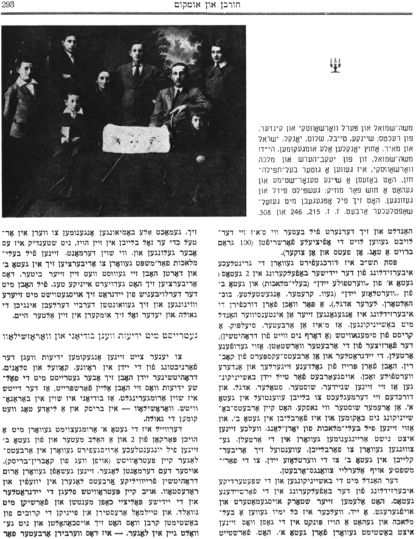
[Page 292]
[photos:] On the left is R. Avraham Simcha, son of Yisrael Perkovsky, born in 1861 in Telyaki, near Kobrin. He was the custodian of the New House of Study. On the right is his daughter Freidka, the wife of Tevel Zbar. May G-d avenge their blood!
The community quickly came to feel that the Judenrat members and the police were nothing but trouble for the community. Of the elected Judenrat members, five were honest men who sought to alleviate Jewish suffering as much as possible. Unfortunately, their abilities were inhibited by other members who argued with them, and who wanted to take advantage of the situation for their personal benefit.
At the same time as the Judenrat was established, Menachem Averbuch organized an aid committee in Drohitchin for the refugees from Shereshov, Khomsk and surrounding villages who arrived without any possessions or money. Averbuch came from Lemberg after the occupation. He had been in hiding when the Soviets had exiled former merchants to Siberia. He was very familiar with Jewish suffering, and when he came home he claimed that Jews should only be concerned with self-help, and that the Jewish administration should merely create organized chaos by doctoring the record books so that the Germans would never know exactly how many Jews there were or where they lived. The self-help committee included Eliyahu Eisenstein, Rabbi Kalenkovitch, Rabbi Altvarg, and the rabbi of Shereshov; the ritual slaughterers Moshe Prager and Yosef David Schub; teachers Wolfson and Rock; doctors Schechter and Lampa, and others.
The community liked the committee very much. In addition to the aforementioned institutions Drohitchin had another active organization: the burial society led by Moshe Aharon Berg.
4.
The Jews of Drohitchin are herded into ghettos
People started talking about a ghetto for the Jewish community as soon as the Germans arrived. No one had any idea of how large the ghetto would be, or how life would be like in the ghetto, but everyone felt that the ghetto was going to be the beginning of the end.
The ghetto became overcrowded, and over a period of months the Jews gradually got used to the harsh conditions, and didn't notice how bad the conditions were. The ghetto decrees started by moving Jews away from the Sand (the name of the street leading to the New Cemetery where many Poles lived), and from parts of Edward Dunin Markevitch Street (the Khomsk alley).
This decree only affected a handful of Jewish families. However, there was significant crowding because at the same time a few hundred Jews from Shereshov and Kolonia (a Jewish village not far from Drohitchin) were brought to Drohitchin, where there were also Jewish refugees from Khomsk and surrounding villages. The destruction of Khomsk, the expulsion from Shereshov, Kolonia and other villages expanded the Jewish population in Drohitchin, and from the beginning of the ghetto decrees there were approximately four thousand Jews in Drohitchin.
Jews became deprived of resources. Where only one family had lived previously, there were now at the outset of the decrees two or more. Money, possessions and furniture were handed over as contributions rather quickly. Most of the homes were emptied of practically everything they contained, so people didn't feel the crowding so much. They complained more about the unceasing demand for contributions, and especially about the order not to come into contact with Christians. Drohitchin Christians who lived on Zartishka and Starosilia streets didn't care about the decrees, and would bring their Jewish friends flour, butter, chickens, eggs and other food in exchange for clothes and shoes that Jews were now giving away so the Germans wouldn't take them as contributions. German supervisors and Judenrat policemen would severely punish anyone involved in such transactions. As long as the ghetto wasn't closed off, the Jews were able

[Page 293]
[photo:] Moshe Shmuel and Perl Warshavsky and their children. From right: Sheinka, Teibel, Shalom, Yankel, Yisrael and Meir. Except for Yankel, all perished. May G-d avenge their blood! Moshe Shmuel, a son of Yaakov Hersh and Malka Warshavsky, was a good cantor with a fine voice and a good ear for music. He played the fiddle and sang, and was deeply involved in community work. See pp. 215, 246, and 308.
to get many more items than allowed according to official regulations (100 grams of bread a day, without shortening or sugar).
On Passover 1942, a sweeping transfer of the Jews into two ghettos took place:
Ghetto A was for the “useful Jews” (artisans), and Ghetto B was for the “useless Jews” (former shopkeepers, employees, bookkeepers, teachers, etc.). A couple of weeks prior to the transfer there was intensive activity to obtain working certificates. In exchange for gold watches and other valuables, Sielpuk, a Christian from Simenovitch (a village not far from Drohitchin) and the chairman of the workers' workshop, the Judenrat and an employment expert from Kobrin obtained certificates for Jews attesting that they were tailors, shoemakers, carpenters, etc., thereby enabling them to remain in Ghetto A in the meantime. A poor shoemaker such as Naska didn't get a certificate, and remained in Ghetto B, and many long-standing artisans who were not accepted into the workshops were forced to eventually move to Ghetto B to join the worthless Jews, those ordered to participate in all types of forced labor.
The certificate business and the subsequent transfer of the population into various ghettos exhausted and agitated everyone. A Jew who was always an artisan and who had a house now located within the confines of Ghetto A obviously made every attempt to be part of a workshop so he could remain at home. However, this was not always successful, and as stated earlier, many artisans were ordered to Ghetto B, where life would be very bitter. The transfers took a few days, and many people with Judenrat certificates exchanged homes in the hopes of speedy redemption so they could return home.
Consolation from news about Budiany and Vorozhilov
At that time reports circulated about the destruction of the Jews in Rovno, Kovel and Slonim. Jews in Drohitchin consoled themselves with false reports that they disseminated, saying that the Germans were already encircled, and that Budiany was already in Baranovich, and Vorozhilov was already in Brisk, and liberation was just around the corner.
In the meantime, Ghetto A was surrounded with a fence two and a half meters high, and many young people in Ghetto B were taken to labor camps in Petrovich (on the road from Kobrin-Brisk). Aside from that camp, voluntary labor camps were set up around Drohitchin in Yozefin and Radestov. If the Judenrat and police ever caught people on the road from Petrovich, they would forcibly send him to the labor camp. They would frequently arrest and torture relatives of a particular individual who went into hiding rather than go to work in the labor camp. This would easily solicit workers for Yozefin and Radestov.
Previous Page |
Next Page
JewishGen, Inc. makes no representations regarding the accuracy of
the translation. The reader may wish to refer to the original material
for verification.
JewishGen is not responsible for inaccuracies or omissions in the original work and cannot rewrite or edit the text to correct inaccuracies and/or omissions.
Our mission is to produce a translation of the original work and we cannot verify the accuracy of statements or alter facts cited.
 Drogichin, Belarus
Drogichin, Belarus
 Yizkor Book Project
Yizkor Book Project
 JewishGen Home Page
JewishGen Home Page
Copyright © 1999-2024 by JewishGen, Inc.
Updated 19 Dec 2001 by LA